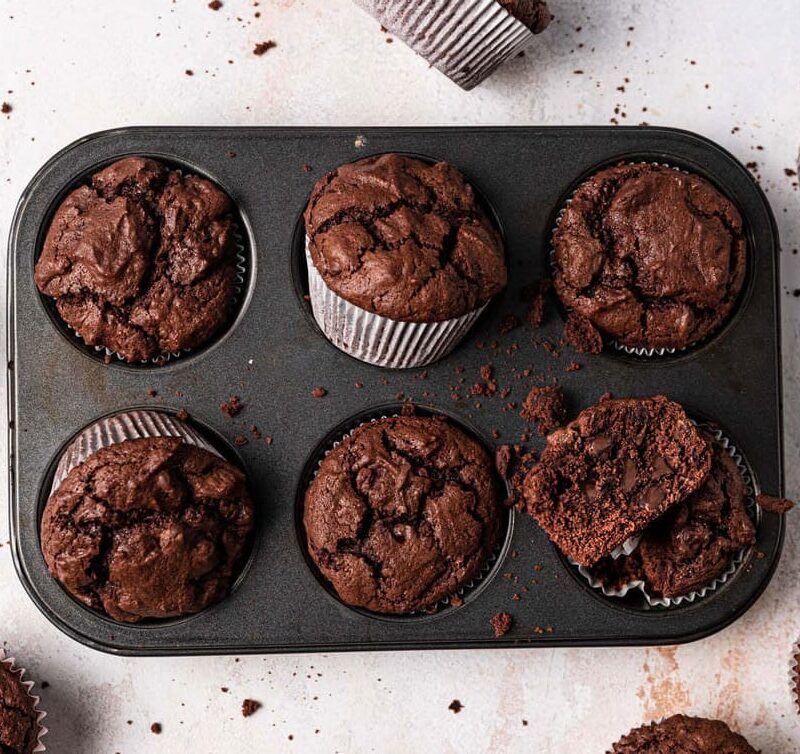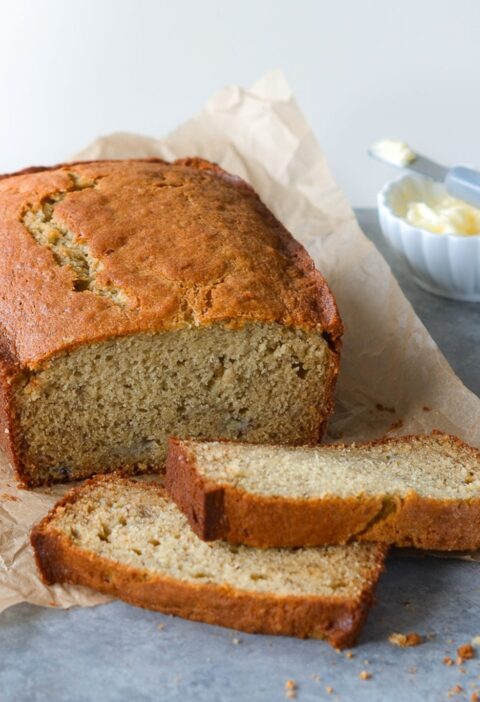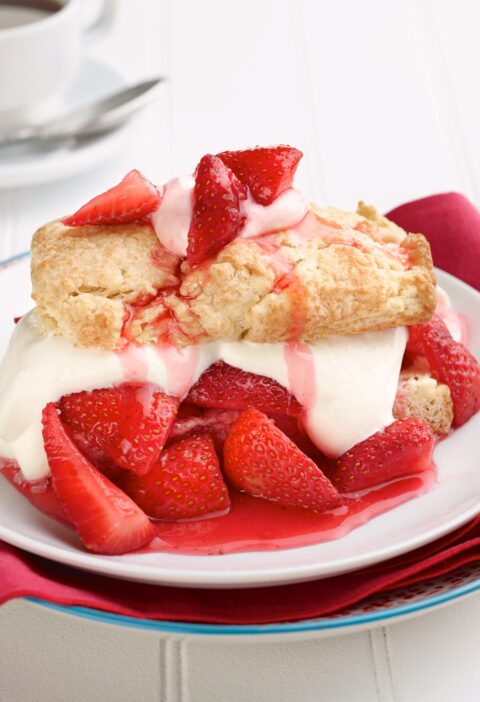(image above) Michelle 2020, Triple chocolate muffins in a muffin tin, Brown Eyed Baker, accessed 4 May 2023, https://www.browneyedbaker.com/chocolate-chocolate-chunk-muffins/
I love muffins. My dad used to buy a triple chocolate chip muffin mix and make them all the time when I was in middle school. They would make me so happy, but then the grocery store near me stopped selling the mix. My dad hasn’t found the same muffin mix anywhere since. I’ve missed those muffins, so I decided that I wanted to learn how to make them and make them well. Baking is a complicated science. One change in the ingredients, temperature, or utensil and the whole chemistry of the baked goods changes.
First, preheat the oven to 375°F. Then get a muffin tin and line it with liners. Now, get a large mixing bowl and add 2 cups of flour, ½ cup of cocoa powder, 1 ½ teaspoons of baking powder, 1 teaspoon of baking soda, and ½ teaspoon of salt. Then get a medium mixing bowl and add 1 cup of sugar, 2 eggs, 1 cup of buttermilk, ½ cup of vegetable oil, and 1 teaspoon of vanilla extract. Next, get a small bowl and add ½ a cup of chocolate chips. Sprinkle ½ a teaspoon of flour on the chocolate chips. Make sure the chocolate chips are coated and then shake off the excess flour. Put the chocolate chips aside. Pour the dry mixture into the wet mixture. Mix them together until they are combined. Now, add the chocolate chips to the mixture and, with a spatula, fold the chocolate chips into the batter. Next, divide the batter into the prepared muffin tin(s). Sprinkle the remaining chocolate chips on top. Then, bake for 14 to 16 minutes.
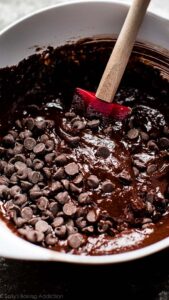
Sally 2020, Triple chocolate batter and chocolate chips, Sally’s Baking Recipes, accessed 4 May 2023, https://sallysbakingaddiction.com/triple-chocolate-muffins/
The first ingredient added to the muffins is flour. The main effect flour has on muffins is how it affects their structure. When the flour is “hydrated” it creates gluten. Gluten is what contains the carbon dioxide that causes the muffins to rise. Gluten affects the texture of the muffin. Muffins are supposed to be tender and airy. The gluten strength depends on what kind of flour is used, the water content, the sugar, the salt, the fats and oils, and the amount of stirring. To create a mild amount of gluten, all-purpose flour is used. All-purpose flour contains 10-11% gluten-forming proteins. It is considered a soft flour, which creates less gluten and absorbs less water. The amount of stirring increases the gluten formation to a point. Large amounts of sugar reduce gluten formation. The effects of fats and oils on gluten depend on when they are added and how much is added. If they are added before water, they reduce gluten formation.
Next cocoa powder is added. Cocoa powder is starch which is a thickener. It contains 6-25% fat (depending on what brand you use), which absorbs water and decreases the final volume of liquid in the batter. The cocoa powder is also responsible for the dark, chocolatey color of the muffins, as well as the main chocolate flavor.
Then baking powder and baking soda are added, which are chemical leavening agents. The rising of a muffin is caused by the chemical reaction between the leavening agent, the acidic, and the base ingredients that form carbon dioxide. The batter around the gas traps it inside. Baking soda releases CO2 gas when it comes into contact with an acidic liquid. The buttermilk is the acidic liquid, which causes it to react and create carbon dioxide. When baking powder gets wet, the sodium bicarbonate and acidic salt react to, also, produce CO2. Baking powder is double acting; it has heat-activated acid and gets a second “lift” during cooking.
After baking powder and soda, salt is added. Salt affects fermentation in muffins. It slows the speed of fermentation as well as prevents any bacteria from developing. It also helps with browning by reducing the destruction of sugar. Salt binds with and strengthens gluten, therefore adding strength to the flour. It also affects the taste of the muffins.
The dry ingredients get added to the wet ingredients because it creates gas bubbles that generate the lift for the muffins to rise. If you were to add the wet ingredients to the dry ingredients the mixture would also become lumpy. The utensils you use to stir the ingredients also affect the density of the muffins. For example, using a whisk to stir the batter adds air.
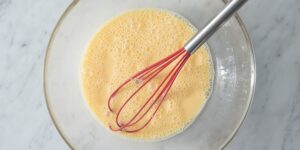
Meredith Food Studios 2023, Whisk in a bubbly mixture, All Recipes, accessed 4 May 2023, https://www.allrecipes.com/types-of-whisks-7486198
The next ingredient added is sugar. Sugar affects the density and moisture of muffins, it is a tenderizer. It also affects the flavor. Sugar and water bond to keep moisture in and prevent the muffins from drying out. Sugar also activates the yeast that causes fermentation, which affects the flavor, color, and texture of the muffins. It also influences the protein coagulation temperature. Sugar increases Maillard browning on the top of the muffins. Maillard browning is a reaction between the reducing sugar and an amino acid. It is responsible for the color of the muffin after is it cooked as well as the flavor of the muffin crust.
Then eggs are added. Eggs affect the color, leavening, texture, and flavor of the muffins. They also have an impact on the structure and the moisture. Eggs are an emulsifier. The yolk of the eggs contains lecithin, which allows for the water and chocolate to come together. When eggs’ proteins coagulate, the eggs act as a glue that helps create the shape of the muffin. If they are not properly balanced with fat and sugar, the muffins can become tough and chewy. The fats and liquids, two things that don’t typically like to combine, are held together by the eggs. This helps to create a batter that is smooth. The eggs also have an effect on the leavening of the muffins because when they are beaten into the batter air gets incorporated. Eggs also add moisture to muffins. The water that is in eggs also helps with leavening. Eggs help to increase the browning of foods. However, they are not the main cause of the browning.
Next buttermilk is added. Buttermilk is acidic and it activates the leaving agents that cause the muffins to rise. That is also why it isn’t added to the dry ingredients and is added towards the last moment. Once the buttermilk is added the baking soda starts to react quickly.
After buttermilk, vegetable oil is added. The vegetable oil helps with the moisture and tenderness of the muffins. The oil also affects how quick the muffin bakes. The more oil there is in a muffin the slower it will bake because the proteins and starch have a more difficult time bonding with water since the water and the fats do not mix. This limits gluten formation, which can cause the muffin to have different textures. When muffins have more oil, the gluten is spread out more, bake slower, and have a more tender texture. Oil also affects moistness because of the prevention of proteins from absorbing water.
Then the vanilla extract is added. Vanilla extract enhances the flavors of the muffins. Without it, the muffins would taste rather bland.
In the recipe, it instructs to mix the batter until it is combined. This is an important statement in the chemistry of the muffins. If muffins are over mixed they tend to be less tender and more tough and dense because of the increase in gluten development. As the batter is mixed proteins form chemical bonds with each other to create the network of gluten. Gluten development affects the air bubbles within the muffins, the shape of the muffin tops, and the texture. When over-mixed the air bubbles are bigger and longer because a stronger gluten network is created. These air bubbles cause the muffins to rise. The heat of the oven causes the air bubbles to expand and then rise. The more the batter is mixed, the stronger the gluten network is and the more the batter holds the air bubbles in.
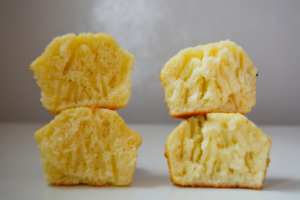
Horbatch 2017, Example of muffins overmixed, Spoon University, accessed 4 May 2023, https://spoonuniversity.com/lifestyle/creative-frozen-treats-to-celebrate-national-ice-cream-day-2022
I am adjusting the baking powder in my recipe. I am going to replace the baking powder with more baking soda and buttermilk since there are already both in the recipe. For every 1 teaspoon of baking powder, I’m going to add ¼ teaspoon of baking soda and ½ a cup of buttermilk, so I will be adding 3/8 teaspoon of baking soda and ¾ cup of buttermilk. Therefore in total, there will be 1 3/8 teaspoons of baking soda and 1 ½ cups of buttermilk. To account for the additional ½ cup of liquid, I will be reducing the eggs and vegetable oil. I will be reducing the 2 eggs to 1 egg (1 egg is about ¼ cup) and I’ll be reducing the ½ cup of vegetable oil to ¼ cup.
I am thinking that substituting the baking powder with baking soda will not change much of the structure of the muffins because they are both leavening agents. However, I do think that adding more buttermilk may cause the taste of the muffins to be more acidic, and sour. I think that reducing some of the liquid ingredients when adding more buttermilk, will not change the density or the texture of the muffins.
If you would like to see the recipe at a glance, click here.
If you would like to see the full recipe with some more detail, click here.
Bibliography
(1) C, C. Overmixing Muffins. CCC’s Curious Kitchen.
https://cccscuriouskitchen.com/overmixing-muffins/(accessed 2023-04-11).
(2) Tessier, A. P. 10 Best Baking Powder Substitutes. The Pioneer Woman.
https://www.thepioneerwoman.com/food-cooking/cooking-tips
-tutorials/g32461023/baking-powder-substitute/
(3) Ryan, M. What Eggs Do In Baking & How It Impacts Your Baked Goods. Food Above Gold.
https://www.foodabovegold.com/what-eggs-do-in-baking/.
(4) The Use of Sugar in Baking. Biscuit people.
https://www.biscuitpeople.com/magazine/post/the-use-of-sufar-in
-baking#:~:text=Sugar%20keeps%20baked%20goods%20soft.
(5) Functions of Salt in Baking. https://opentextbc.ca/ingredients/chapter/functions-of-salt-in
-baking/#:~:text=Salt%20has%20a%20binding%20or.
(6) Baker Bettie. Function of Flour in Baking, Differences in Varieties of Flour | Baker Bettie.
Baker Bettie. https://bakerbettie.com/varieties-flour/.
(7) C, C. Oil in Muffins. CCC’s Curious Kitchen. https://cccscuriouskitchen.com/oil-in-muffins/.
